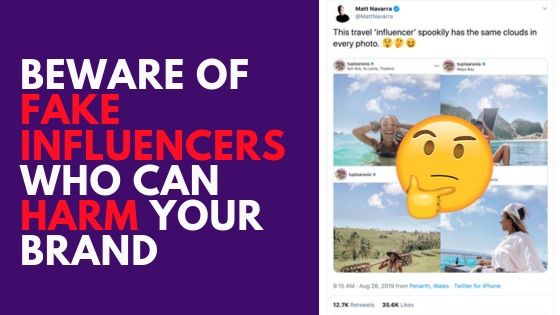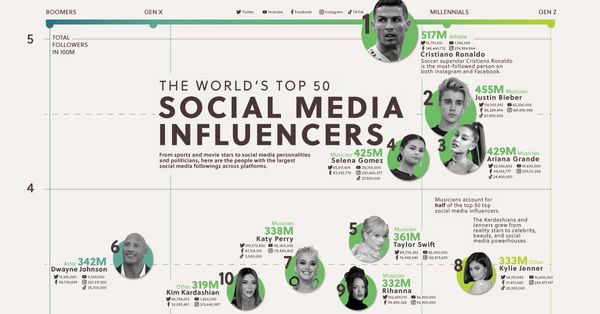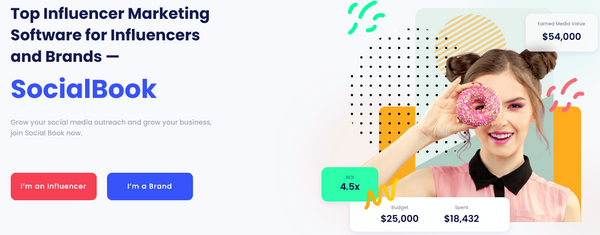By definition, a real influencer has to be capable of influencing the decisions of others. It takes time and much hard work to reach this position. You can't simply declare yourself an influencer overnight. And you can't merely buy influence, and expect people to take you seriously.
The problem is that too many shysters have tried to take shortcuts recently. And too many brands have been burned by the experience.
The team at SocialBook eat, breathe, and live influencer marketing. We have seen all the statistics, and we know many brands who have reported tremendous success from their influencer marketing campaigns. Many of our clients have told us how successful they have been at finding perfect influencers with whom to partner for influencer campaigns. But unfortunately, we have also heard the stories about the seedy side of the industry: the cheats, scammers, and downright fraudsters who impersonate influencers and fail to deliver.
Earlier this year, Mediakix polled the industry for their 2019 Influencer Marketing Survey. One of the questions asked the respondents what they thought were the most significant challenges facing the industry. Fully 50% considered the biggest issue was spotting fake followers and inauthentic engagement. Another survey by Econsultancy polled a group of UK and US marketers and delivered similar results, with 42% calling fake followers their greatest concern.

But it's not all doom and gloom, however. As determined as the fraudsters may be, it isn't that difficult to spot fake influencers. You just need to be alert and do your homework when analyzing potential influencers for your campaign.
This Travel' Influencer’ Spookily has the Same Clouds in Every Photo
The travel "influencer," Tupi Saravia probably looked like someone enjoying the good life, traveling around beautiful locations, enjoying life. As you can see in the posts below (collected by Matt Navarra), she's out in the sun, swimming in tropical waters, living the high life which most of her followers can only dream. According to Tupi Saravia’s Instagram profile, she's a travel blogger from Buenos Aires, Argentina.

But take a close look at those photos, helpfully grouped by Matt Navarra. Do you notice something a little odd? According to the captions, Ms. Saravia is at Koh Rok, Ko Lanta, Thailand in the first picture, Maya Bay in the second, somewhere unnamed in the third picture, and Porto Santa Margharita in the fourth. Yet the cloud formations are identical in each photo. Is this a coincidence? Hardly likely.
Perhaps the most disturbing part of this is that people replied to the tweet trying to justify the fake photographs. According to somebody called Meg, "God forbid people actually edit their photos. It’s done all the time in marketing. Did you know cereal ads actually use glue instead of milk? Oh, the deception!!" Liquid|Gabrielle also didn't see anything wrong: "So she could be a bit more creative with the placement of the cloud PNGs, but what’s the issue with this exactly? This is common practice for nearly every relevant brand and influencer. This is the least fake and tamest form of content manipulation that exists.”
Well, here's some new to you, Gabrielle, not all influencers fake their pictures. Indeed, genuine influencers, who have authority and trust, and actually influence their followers' decisions, know that unless you're a magician, you don't attempt to fool your audience.
I will give Tupi Saravia some credit. She did admit using a photo-editing app to enhance or impose clouds into her photos, once approached on the issue. "I used an app called Quickshot to help the composition of the photograph when the sky is burned or overexposed," she commented. She claims she's always been open about her image manipulation.
However, she still struggles to understand why she has upset people. "I really don't see the big deal [here], I never lied about it," she said. "I haven’t done anything wrong, and it was never my intention."
Fake Influencers are Not Rare
Tupi Saravia's posts may not be a particularly severe case of fakeness – while her clouds may be false, there is no indication that her travels were, too. But there have been too many fake "influencers" online who have claimed influence that they have never earned.
And from a brand's point of view, a lack of genuine influence equates a lack of an interested, relevant audience, who will take notice of the sponsor's product.
The New York Times reported on this current phenomenon of fake influencers with their fake followers. They highlight the case of Jessica Rychley, a Minnesota teenager, who found that she has an impersonator – a phony version of herself who hawks Canadian real estate investments, cryptocurrency and a radio station in Ghana, as well as pornography (despite the "real" Jessica still only being 17 at the time).
Here's the screenshot from the original New York Times article, comparing the real Jessica and the phony version of her account:

When the New Your Times article was written, in 2018, there were estimates that "as many as 48 million of Twitter’s reported active users — nearly 15 percent — [were] automated accounts designed to simulate real people". Twitter and Instagram have tried to clean up their accounts since then, but it shows that you need to be wary when searching for influencers and blindly accepting stated follower numbers.
At that time, one company, Devumi, was responsible for much of the fraudulent activity. They had "more than 200,000 customers, including reality television stars, professional athletes, comedians, TED speakers, pastors, and models.” Devumi may not have survived the publicity, but that doesn't mean that the problem of fake influencers with fake followers has disappeared.
Proctor and Gamble had taken real umbrage at the issue of fake influencers. They have systematically tried to rid themselves of fake influencers and their unreal followers.
Points North Group carried out a survey in 2018 to determine which big-name brands employed the most "influencers" with fake followers. They found that 78% of the followers of Ritz-Carlton's so-called influencers were fake.
Many So-Called Influencers Aren't Genuine Influencers At All
The mass media has a lot to answer. In many ways, they have written many articles about influencer marketing and queried its success as a marketing mechanism. One of the biggest problems, though, is a common misunderstanding of what an influencer is.
We can't emphasize enough. Just because you have a massive number of followers, does NOT make you an influencer. Influencers have to influence their followers' thoughts and behavior. They have to act as thought leaders in their topic of expertise.
Tupi Saravia may think of herself as an influencer. Many of the people writing about her certainly assumed she was. Yet, who is she claiming to influence? Does she have a solid group of followers who believe that she's a thought leader on travel?
If you are a brand searching for influencers, you need to look at a wide range of statistics and data, to determine whether somebody truly acts as an influencer to their follower-base. You need to look at the posts and conversations to decide whether they are a leader in their field or just somebody who uploads and shares pretty pictures to a diverse audience of people.
Elinor Cohen touched on the issue in her article: It’s time to address the elephant in the room: Influencers don’t really influence anything or anyone!
But she also fell into the trap of assuming that anybody with a decent following is an influencer. She separated thought leaders from influencers. But the problem is that it fails to recognize that the "non-influential influencers" aren't influential at all. They are merely fake people misusing the word "influencer." Ms. Cohen's "genuine thought leaders" are the real "influencers" – and should be the only ones to carry that name.
How Fake Influencers Will Harm Your Brand
Ultimately, when a brand partners with an influencer, they do so on the assumption that the influencer has a certain-sized audience of (hopefully) relevant followers. If the brand's done its homework, then it will have picked a suitable influencer, whose audience aligns with the brand's target customers.
If an "influencer" cheats and artificially inflates his or her follower numbers than that brings the whole influencer section process into question. The higher the quantity of "real" followers an influencer has, the more money that person can justify charging.
The problem with fake influencers is that a portion of their followers are bots and others are irrelevant people who have no interest in what the "influencer" posts. Fake followers are NEVER going to buy your product.
Unfortunately, there are still too many firms that equate follower numbers with influence. In reality, it is what influencers do or say that makes them "real" influencers. It is the thought leaders who have the power to change their followers' behavior. It is not "Ms (or Mr) Popular who skites about having the most followers, and who makes vapid, irrelevant posts that are of little benefit to anybody.
How to Spot Fake Influencers
It is surprisingly easy to spot if so-called influencers have bought fake followers. You only have to look at their statistics. You will find everything you need within SocialBook.
Suspicious looking Changes in Follower Numbers
One of the easiest ways to spot the existence of fake followers is to look at the pattern in the acquisition of the influencer's followers. In most genuine cases, influencers will gradually increase their followers over time. Sure, they will go up and down to an extent, but overall, you will notice a relatively consistent rise in follower numbers over time.
If somebody buys fake followers, you will notice a sudden surge in follower numbers, followed by a gradual falling off in numbers. A distinct vertical line in follower numbers should always make you suspicious.
Here's the Instagram follower tendency of Tupi Saravia on SocialBook, the travel "influencer" I mentioned above. It is clear there is a sudden surge in follower counts around August 2018, while the tendency is quite stable before and after that.

You should even be suspicious if you see a sudden drop in follower numbers. This may indicate that the "influencer" bought numbers in the past, and the social network has just discovered they were fake, closing down their accounts.
Engagement Rates Different from the Norm

You should also look for atypical follower-to-engagement ratios. If an account has low engagement in proportion to its follower numbers, then there is a high likelihood that many of the followers will be fake. SocialBook calculates the engagement rate of each channel (as shown left) to help marketers to identify low-quality influencers.
You might sometimes spot that somebody has identical engagement on all their posts. This is too consistent to be accurate and a sign that they have bought engagement.
When you look at engagement rates, bear in mind that accounts with fewer followers tend to have lower engagement rates than larger accounts. You will want to compare engagement rates across a range of similarly-sized accounts on your preferred social network to determine if anybody is out-of-line.
Engagement Quality
Some fake influencers (and the firms who provide them followers as a service) have realized that a low engagement may be a problem, so thy have created bots (or paid low-income contractors) to make comments. But if you look closely at these comments, they tend to be vague, nonsensical and generally of little value.
If you see lots of short, simplistic comments like "nice pic," "good post," and "well done," then you can disregard these as examples of engagement. They are pointless and very often the results of payments for fake engagement.
Sure, even the best influencers will get some low-quality comments, like the above examples, or even some that consist only of emoji. But they also receive high-quality, thoughtful comments. Remember, influencers are supposed to be thought-leaders, so you would expect their audience to express their thoughts on the influencer's posts coherently. You preferably want to see comments that directly refer to the content of a post.
Be on the lookout for a consistent set of commenters too. This could be a sign that an influencer is part of a comment pod – a group of people who all comment on each others' posts.
Need help to identify fake influencers? Find the right influencers best for your brand with SocialBook.
This article was originally posted on my LinkedIn: https://www.linkedin.com/pulse/beware-fake-influencers-who-can-harm-your-brand-heidi-yu/








